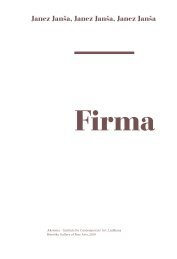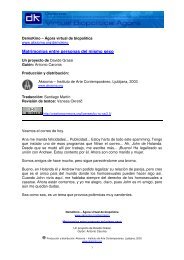You also want an ePaper? Increase the reach of your titles
YUMPU automatically turns print PDFs into web optimized ePapers that Google loves.
After the Second World War, certain artists worked withsignatures or simulacra of signatures, shifting the value ofan authentic inscription of the artist towards a de-centred,displaced or over-identified token. Robert Rauschenbergerased a de Kooning drawing. All that was left from the art-62 spleta in komunikacije po elektronski pošti, se avtentičniestablished in 1871. Graphology emerged as a technique orskill of interpretation of handwriting, especially in relationto the human psyche and was connected with diagnosticpractices treating brain diseases or those of the nervoussystem. It became a part of police studies, used in verifyingtrue or false, i.e., falsified, signatures. The relation betweenthe authentic and false signature is one of the great mystificationsof the Western civilisation – there has alwaysbeen the question: Who is really the person behind thesignature?63lastnoročni podpis nadomešča z „elektronskim“.V kontekstu razprav o lastnoročnem pisanju in podpisovanjuje treba omeniti grafologijo. Grafologija kot „študijarokopisa“ je znanost ali psevdoznanost. Verjetno se jepojavila ob koncu 16. stoletja s konstruiranjem modernegasubjekta in zahtevo po puščanju avtentične sledi – podpisana dokumentih in v pismih. Prvo grafološko društvo je biloustanovljeno leta 1871. Grafologija se pojavi kot veščina alitehnika tolmačenja rokopisov, zlasti v zvezi s človeško psiho.Povezujemo jo z diagnostičnimi praksami, s katerimi serazis kujejo bolezni možganov in živčnega sistema. Grafologijaje del policijskih študij – v teh okvirih gre za verifikacijoresničnega ali lažnega, tj. ponarejenega podpisa. Odnosmed avtentičnim in lažnim podpisom je ena izmed velikihmistifikacij zahodne civilizacije – saj se zmeraj zastavljavprašanje, kdo zares stoji za podpisom.Podpis ali signatura (signare) je označba za avtentično inberljivo sled individuuma oziroma za avtentičnega avtorjaumetniškega dela. Na primer, Ludger tom Ring je svoja delasigniral v obliki prstana. Anonimni mojster iz Berna jih jeoznačeval z znakom nageljna. Rubens je svoja dela označevals tiskanimi pisanimi inicialkami PPR. Označba za umetnikav okviru umetnine postane pogosta od 15. stoletja. Zamoderne umetnike 19. in zgodnjega 20. stoletja je podpispostal nekakšen „znak avtentičnosti dela“ in „ustvarjanjablagovne znamke dela“ – npr. van Goghovi ali Picassovi podpisi.Umetniki dade (Marcel Duchamp, Francis Picabia) uporabljajopodpis kot znak, ki potrjuje, da je umetniško deloali predmet vsakdanjika prilaščen z dejanjem podpisovanja.Picassovi in Duchampovi podpisi so postavljeni inverz no.Picasso z dejanjem podpisovanja potrjuje, da je delo „ustvarjeno“z njegovo roko, Duchamp pa s svojim lastnim ali prilaščenimimenom (psevdonimom) nakazuje, da je dejanjeimenovanja pravzaprav dejanje kulturnega prilaščanja inpreusmeritve objekta v polju simboličnega kapitala.The signature (signare) is a mark for the authentic andlegible trace of an individual, for the authentic author of anartwork. For example, Ludger tom Ring signed his workswith a ring-shaped symbol. The anonymous master of Bernmarked his works with a symbol of a carnation. Rubenssigned his paintings with capital letters PPR. Since the15 th century the mark of the artist contained in the workbecame more widespread. For the modern artists of the19 th and the early-20 th century, the signature became a“sign for authenticity of the work” and its “trademark” –note, for instance, the signatures of Van Gogh or Picasso.Dadaists like Marcel Duchamp or Francis Picabia used thesignature as a confirmation that an artwork or an ordinaryobject was appropriated by the signing act. Picasso andDuchamp signatures were conceived inversely. With thesigning act, Picasso confirmed that a piece was “made” byhis hand. Duchamp, with his own or adopted name (pseudonym),demonstrated that the act of naming was in factan act of cultural appropriation and shifting of the objectto the realm of the symbolic capital.




